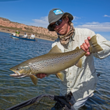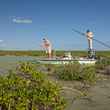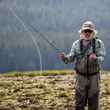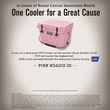Troy went tutti-frutti. I, chartreuse and white.
Color. It’s the key. Find the right combination and you can fill the boat with rockfish. If not, you’ve got a long day ahead. It’s all about color.
For the most part, fly fishing for stripped bass as they move up the river to spawn has a basic formula; eight or nine weights, 350-500 grain sinking lines (depending on flow) and sizable clousers. Chuck and duck, count it down to the bottom, and retrieve in short, snapping strips until you feel the leader tick into the rod tip that you’ve buried as deep as you can off the side of the boat. Wait for the thump. It’s hard work and a day of it will wear on you.
So us the sun rose, we opened the boxes and ruffled through the deer hair. Troy started with his favorite pink-and-white while I tied on red and yellow. Nothing happened. Troy switched to tutti-frutty (pink and chartreuse) and I pulled out chartreuse and white and we each boated a couple in a five-minute spurt, proving nothing. As quickly as they started, the bites went away.




























